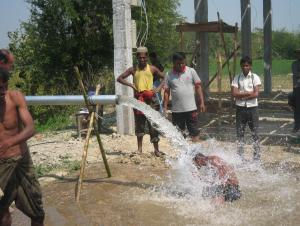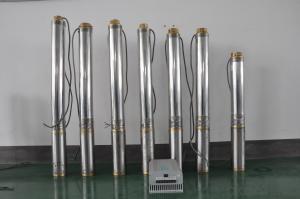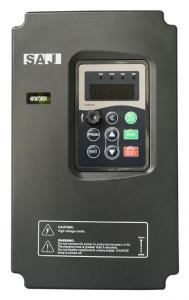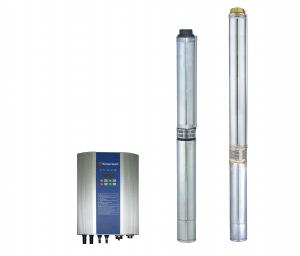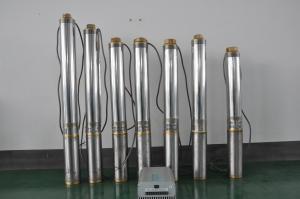DC Solar Pumping Systems Popular Type Good Quality
- Loading Port:
- Shekou
- Payment Terms:
- TT OR LC
- Min Order Qty:
- 10 set
- Supply Capability:
- 6000000 set/month
OKorder Service Pledge
OKorder Financial Service
You Might Also Like
Products
DC Solar Pumping System can be applied to daily use (ground water), agricultural irrigation, forestry irrigation, desert control, pasture animal husbandry, water supply for islands, wastewater treatment engineering, and so on. Solar water pump System is dispensed with energy storing devices, and stores water instead of electricity. It improves the reliability of the device, at the same time, it lowers the construction and maintenance costs of the irrigation system dramatically.
In recent years, with the promotion of the utilization of new energy resources, Solar Pumping System is more and more used in municipal engineering, city centre squares, parks, tourist sites, resorts and hotels, the landscapes and fountain irrigation systems in the residential areas.
Technical Features
Optimization of Single Pump System
A single solar irrigation system consists of only one pump, a power -matched solar array and an inverter . The aim of optimization is to reduce the amount of PV modules as much as possible on the premise of filling the requirement of head and capacity. The rotational speed of pump is regulated according to the irradiation on the solar array; when the sunlight reaches its peak, the pump runs at the rated speed, and the output approaches the peak power of the solar array; when the sunlight is less abundant, the speed of pump varies bellow the range of the rated speed; when the speed as low as the capacity becomes zero, the solar pumping system stops working. So, there are big differences between solar irriation systems and traditional pumping systems in system design, and the system should be optimized according to the requirements of head, capacity, and local conditions of sunlight.
•Determine the optimal average daily operating time and the range of speed governing.
•Choose the optimal head and capacity of the pump.
•Determine the maximum power of PV modules, the best working voltage and method of connection.
Optimization of Multi-pump Systems:
There are several pumps in a multi-pump system. The pumps can be driven either by only one high-power inverter, or by several matching inverters. In the case of large capacity demand, the operation of the multi-pump system is more flexible. By switching solar arrays and pumps, all of the pumps run in MPPT mode when the sunlight is abundant, while some pumps will be shut down and all solar arrays supply power intensively for the rest running pumps when irradiation is weak. Based on the optimization of single pump system, the range of speed can be further optimized, and the photovoltaic(PV) pumping system always works with high efficiency.
Product Specifications
Model | Rated Power | Max. Flow | Max. Lift | Daily Water Supply | Outlet Dia. | Pump Dia. |
PSD600C | 600W | 4.5 m3/h | 30 m | 10 - 20 m3 | 1"1/4 | 4" |
PSD600H | 600W | 2 m3/h | 100 m | 5 - 10 m3 | 1"1/4 | 4" |
Solar Array Configuration
Max. Input Power | Max. Input Current | Max. Open Circuit Voltage | Recommended MPP Voltage |
1000W | 15A | 150VDC | 60 - 120VDC |
Recommended Design | Solar Panel | Connection | Total Power |
Configuration 1 | 190W / 35Vmp | 2 pcs x 2 strings | 760W |
Configuration 2 | 250W / 30Vmp | 3 pcs x 1 string | 750W |
Performance Curve
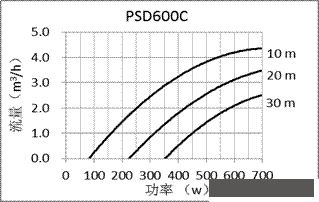
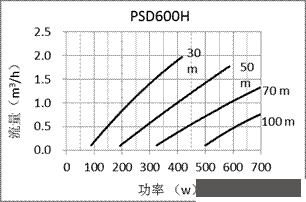
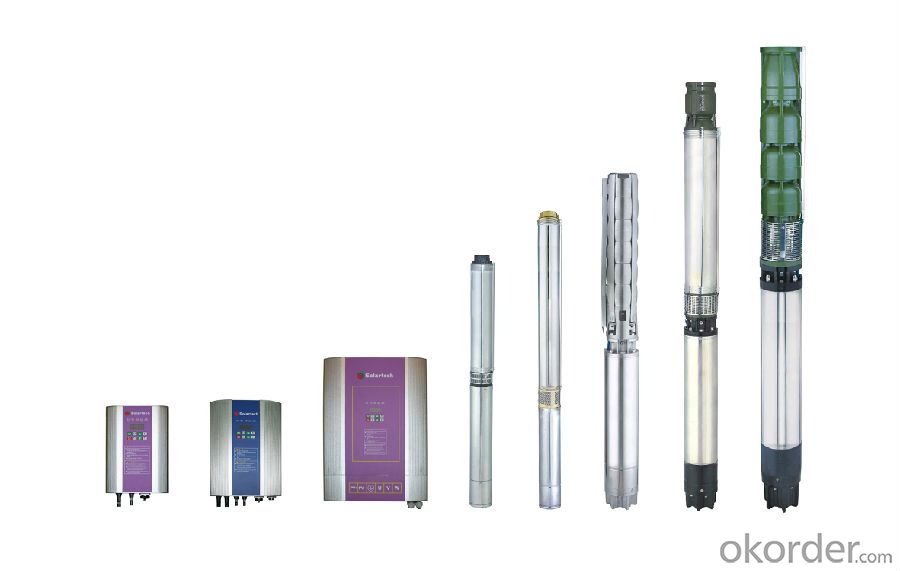
- Q:What is the expected lifespan of the controller used in a solar pump system?
- The expected lifespan of a controller used in a solar pump system can vary depending on various factors such as the quality of the controller, the brand, and the environmental conditions it is exposed to. Generally, a well-made and properly maintained controller can last anywhere from 5 to 15 years or even longer. High-quality controllers designed specifically for solar pump systems are usually built to withstand harsh weather conditions, such as extreme temperatures, humidity, and dust. They are also equipped with protective features like surge protection and overvoltage protection to safeguard against electrical fluctuations and power surges. Regular maintenance and periodic inspections can extend the lifespan of the controller. This includes cleaning the controller to remove dust and debris, checking for loose connections, and ensuring proper ventilation to prevent overheating. It's worth noting that some manufacturers offer warranties for their controllers, which can provide additional peace of mind regarding their expected lifespan. Therefore, it is important to consider factors such as the controller's quality, brand reputation, environmental conditions, and maintenance practices when estimating the expected lifespan of a controller used in a solar pump system.
- Q:Can solar pumps be used for water supply in wildlife reserves or conservation areas?
- Yes, solar pumps can be used for water supply in wildlife reserves or conservation areas. Solar pumps are an eco-friendly and sustainable solution that can provide a reliable water source for wildlife, helping to maintain their habitats and support their survival. Additionally, the use of solar pumps reduces the dependence on non-renewable energy sources, making it a more environmentally conscious choice for water supply in such areas.
- Q:Are there any specific maintenance tasks for the solar panels?
- Indeed, for solar panels to achieve their optimal performance and long lifespan, there exist specific maintenance tasks that necessitate execution. Among these tasks, one must regularly cleanse the panels to eliminate accumulated dirt, dust, and debris that can impede their efficiency over time. This process typically involves employing water, a soft brush or cloth. Additionally, it is crucial to thoroughly inspect the panels for any indications of harm or deterioration, such as cracks or loose connections, and subsequently arrange for the necessary repairs or replacements. It is also recommended to monitor the system's performance and examine the inverter for any potential errors or faults. Moreover, it is important to trim any nearby trees or plants that may cast shadows on the panels, and consistently verify the stability of the mounting structure and fasteners as part of the maintenance routine. To obtain more precise maintenance requirements based on the specific type of solar panel system installed, it is advisable to consult the manufacturer's guidelines or enlist the assistance of a professional.
- Q:Can a solar pump be used for water treatment in developing countries?
- Yes, a solar pump can definitely be used for water treatment in developing countries. Solar pumps are a sustainable and cost-effective solution that can help provide clean and safe water for communities in need. They can be used to power filtration systems, disinfection processes, and other water treatment technologies, making them ideal for addressing waterborne diseases and improving overall water quality in these regions.
- Q:Can a solar pump be used in areas with limited access to water availability?
- Yes, a solar pump can be used in areas with limited access to water availability. Solar pumps are designed to operate using sunlight as their primary source of power, making them ideal for remote or off-grid locations where electricity supply may be unreliable or non-existent. These pumps can be used to extract water from various sources such as wells, rivers, or lakes, providing a sustainable solution for communities facing water scarcity. By harnessing solar energy, these pumps offer a cost-effective and environmentally friendly way to access water in areas with limited water availability.
- Q:Are there any limitations to the temperature of the water a solar pump can handle?
- Yes, there are limitations to the temperature of the water that a solar pump can handle. Most solar pumps are designed to handle water temperatures up to a certain limit, typically around 60-70 degrees Celsius (140-158 degrees Fahrenheit). Exceeding this temperature can potentially damage the pump's components and reduce its efficiency. It is important to ensure that the water temperature remains within the specified range to ensure the proper functioning and longevity of the solar pump.
- Q:Can a solar pump be used for water supply in remote research stations or observatories?
- Yes, a solar pump can definitely be used for water supply in remote research stations or observatories. Solar pumps are powered by solar energy, which means they do not require electricity from the grid or any fuel to operate. This makes them a perfect choice for remote locations where access to electricity may be limited or non-existent. Solar pumps are designed to efficiently pump water from a well, borehole, or other water sources, and can be used to supply water for various purposes such as drinking, irrigation, or other research-related activities. Additionally, solar pumps are easy to install and maintain, and their operation costs are significantly lower compared to traditional fuel-powered pumps. With the abundance of sunlight available in most remote locations, a solar pump provides a sustainable and reliable solution for water supply in research stations or observatories.
- Q:Can a solar pump be used in remote monitoring systems?
- Yes, a solar pump can be used in remote monitoring systems. Solar pumps are ideal for remote locations as they operate using solar energy, making them independent of grid electricity. This makes them suitable for remote monitoring systems that require water pumping, such as remote weather stations, agricultural monitoring systems, and environmental monitoring systems in remote areas. The solar pump can provide a reliable and sustainable solution for powering the water pumping needs of these remote monitoring systems.
- Q:How does the cost of maintenance for a solar pump system compare to a traditional electric pump?
- The cost of maintenance for a solar pump system is generally lower compared to a traditional electric pump. Solar pump systems primarily rely on renewable energy, which means they do not require electricity from the grid, resulting in reduced operating costs. Traditional electric pumps, on the other hand, require a constant supply of electricity, which can be costly, especially in areas with high electricity rates. Solar pump systems have fewer moving parts compared to traditional electric pumps, making them less prone to mechanical failures. This translates to lower maintenance and repair costs. Additionally, solar pumps do not require fuel or lubrication, which further reduces maintenance expenses. Furthermore, solar pump systems have longer lifespans compared to traditional electric pumps. While electric pumps typically last around 10-15 years, solar pumps can last up to 25 years or more with proper maintenance. This longer lifespan minimizes the need for frequent replacements and associated costs. In summary, the cost of maintenance for a solar pump system is generally lower than that of a traditional electric pump. The reduced reliance on grid electricity, fewer moving parts, and longer lifespan contribute to the overall cost-effectiveness of solar pump systems in terms of maintenance.
- Q:Are there any limitations to the flow rate of water a solar pump can handle?
- Yes, there are limitations to the flow rate of water that a solar pump can handle. The flow rate of a solar pump is usually determined by the size and capacity of the pump, as well as the amount of sunlight available to power the pump. The size and capacity of the pump will determine its maximum flow rate. If the pump is too small or has a limited capacity, it may not be able to handle high flow rates of water. In such cases, the pump may struggle to deliver water efficiently or may even fail to pump water at all. Additionally, the amount of sunlight available to power the solar pump can also impact its flow rate. Solar pumps rely on solar panels to convert sunlight into electricity, which is then used to power the pump. If there is insufficient sunlight or if the solar panels are not properly positioned or maintained, the pump may not receive enough power to operate at its maximum flow rate. It is also worth noting that the flow rate of a solar pump may vary depending on the time of day and weather conditions. For example, during cloudy days or in the early morning or late afternoon when the sun is less intense, the flow rate may be reduced. Therefore, while solar pumps are a sustainable and eco-friendly solution for water pumping, they do have limitations in terms of flow rate. It is important to carefully consider the size and capacity of the pump and ensure proper maintenance of the solar panels to optimize the flow rate of water.
1. Manufacturer Overview |
|
|---|---|
| Location | |
| Year Established | |
| Annual Output Value | |
| Main Markets | |
| Company Certifications | |
2. Manufacturer Certificates |
|
|---|---|
| a) Certification Name | |
| Range | |
| Reference | |
| Validity Period | |
3. Manufacturer Capability |
|
|---|---|
| a)Trade Capacity | |
| Nearest Port | |
| Export Percentage | |
| No.of Employees in Trade Department | |
| Language Spoken: | |
| b)Factory Information | |
| Factory Size: | |
| No. of Production Lines | |
| Contract Manufacturing | |
| Product Price Range | |
Send your message to us
DC Solar Pumping Systems Popular Type Good Quality
- Loading Port:
- Shekou
- Payment Terms:
- TT OR LC
- Min Order Qty:
- 10 set
- Supply Capability:
- 6000000 set/month
OKorder Service Pledge
OKorder Financial Service
Similar products
New products
Hot products
Hot Searches
Related keywords
